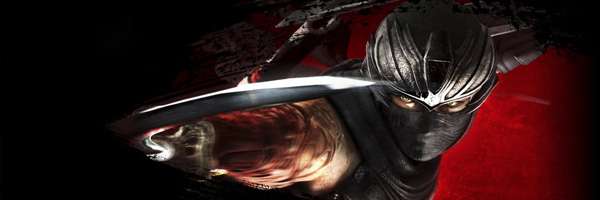
Ninja Gaiden 3: Razor’s Edge PS3 Review
Recently, it feels as if developers have really dropped the ball on some of gaming’s most beloved franchises and have been actively working to make attempts to salvage their damaged brands. Final Fantasy XIV was a shoddily-developed, critically panned MMO upon launch, to which Square Enix is now spending millions of dollars and manpower to rebuild and re-release the game under a new subtitle. Mass Effect 3 featured an ending so reviled by fans that Bioware eventually patched a “Special Edition” that expanded on the abrupt and confusing climax. Capcom also dropped the ball with Resident Evil 6 in almost every regard, to which they have also attempted to fix with patches for the console versions as well as an expanded PC re-release.
While Square Enix certainly deserves the prize for their failure and ambitious do-over, Tecmo-Koei’s mishandling of Ninja Gaiden 3 should also be considered as a close runner-up. Recognizing the ire from fans, Tecmo attempted to re-package it as a Wii U launch title, Ninja Gaiden 3: Razor’s Edge, adding in dozens of sorely-missed features such as multiple weapons and re-balanced difficulty, as well as a couple of exclusive missions starring Ayane. Obviously this did little to please PS3 and 360 owners who weren’t interested in investing in a new system, but as with most third party Nintendo “exclusives,” Razor’s Edge has now found its way back to those systems as well.

Before detailing the changes made to the game, let’s discuss the one thing that hasn’t changed – the story. At the behest of the Japanese Self Defense Force, modern-day ninja Ryu Hayabusa must travel to different parts of the world to eliminate a group of terrorists led by a mysterious cult of magic-using alchemists. After slaughtering an entire army of PMCs and their Anime-looking robot tank, Ryu encounters the masked cult leader known as the Regent of the Mask, who places a blood curse on Ryu’s right arm. Filled with murderous rage that seems no different from the murderous rage he was displaying earlier, Ryu most suppress the curse on his arm while unraveling the malicious intentions of the cult before their world-conquering plans are put into motion.
The previous two Ninja Gaiden games were hardly the pinnacle of video game storytelling, but they still sufficed as goofy power fantasies that never got in the way of the gameplay. Ninja Gaiden 3 ignores both of these points with overly long exposition as well as taking itself far too seriously. Scenes that feature a super-powered ninja like Ryu holding top secret meetings inside a Japanese naval ship while also getting tongue-tied when a precocious little girl asks him to be his new daddy are just some of the dull moments that will have players reaching for the skip button. Likewise, the new villains are equally boring, consisting mostly of foul-mouthed terrorists all hailing from the same British country as well as a goofy masked man who would barely serve as an early level boss in the NES Ninja Gaiden titles, not to mention the unintentionally hilarious inaccuracies in his biblical metaphors.
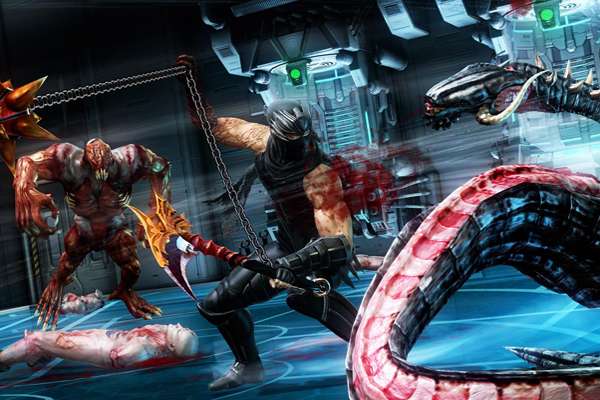
As for the gameplay, much has been changed, removed, and improved upon since the original botched release. Enemies will no longer beg for their lives, instead constantly shouting obscenities at players as they have their various limbs removed. They also behave far more aggressively and will also attempt to dodge or block attacks, and will attempt to take you out with a devastating kamikaze attack once they’ve lost an arm or leg. The stiff controls and movement have also been adjusted back to the fluid feel of the previous NG games while also returning Ryu’s arsenal of weapons and Ninpo skills, as well as upgradable abilities and weapon power-ups by spending karma points. This upgrade tree can be accessed at any time during the game rather than waiting to access a checkpoint.
The inclusion of these features would, in theory, bring Ninja Gaiden 3 back to the quality of the first two games. Unfortunately, by attempting to fix some issues, Tecmo has added a whole host of new ones to get frustrated over. The most prevalent is the difficulty curve or, rather, the difficulty ten-car pileup. In an attempt to bring back the brutal challenge of the previous games that fans loved so much, NG3 has taken far too many steps to make players feel miserable instead of motivated. Chief among them is the removal of all healing items; whereas the previous game allowed you to stock up on herbs and other items to get you out of a pinch, NG3 only has two ways of restoring lost health – at the end of an enemy wave, or by using a Ninpo spell.
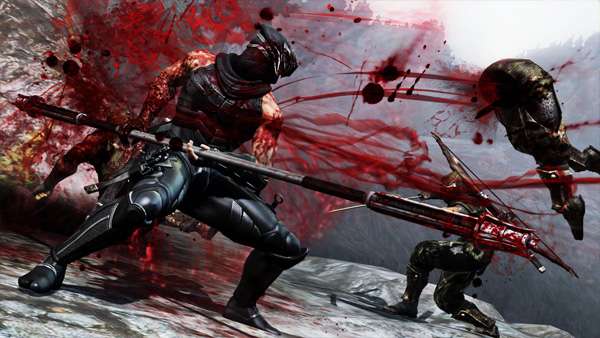
This may sound like a reasonable compromise that encourages players to improve their skills during battle, but this concept is hampered by the utterly punishing amount of foes tossed your way in each wave. Dozens of armed foes will bum rush players in groups, slashing and shooting in every direction with unrelenting force. Should you succeed in dispatching the group of foes blocking your path, you will be treated to another group of enemies looking to take a swing at you, followed by yet another group, and sometimes a mini-boss. None of the enemies are any tougher than the ones in previous NG games and all feature patterns that should be easy enough to observe, but the sheer number of baddies that the game relentlessly tosses at you becomes not only physically exhausting, but also boring. Players will too often be forced to truck on through for minutes at a time during these fights only to lose your last precious sliver of health at the very last foe, which means starting the battle all over again from the first enemy.
Also, it should be noted that Ryu is evidently made of paper this time around – one single hit can bring down a quarter of your health. Lose less than half and the game will display an annoying low health indicator in the form of a beating heart and a blood-red filter that takes up the entire screen. Get used to this effect, because it will plague your gaming experience for over 90% of the time. To compound matters, your base health also decreases after repeated attacks and will not recover fully until you have reached a save point. This does not reset after reloading a Game Over, either, so you can look forward to restarting incredibly long, incredibly damaging battles with even less health than before
If there is one silver lining to the torment of NG3’s difficulty, it’s the patented “Steel on Bone” mechanic. Essentially a devastating counter move, the mechanic involves dodging an enemy’s heavy attack (always indicated as a glowing red strike), then hitting the Y button to slice through their innards. This move will not only instantly kill the attacking opponent, but can be chained to carve through surrounding enemies as well. Being able to take out half a dozen foes in a matter of seconds does invoke a certain amount of bloody satisfaction, but it also creates the notion of having to wait for the opportune attack to initiate the counter. The concept of not constantly attacking enemies is one that should never be present in the lightning-fast-paced action of the NG series and is also hampered by the relentless standard attacks from surrounding foes. Even the room-clearing Ninpo spells take forever to accumulate energy and are now forced to be kept in reserve so that you can regain that crucial amount of health.
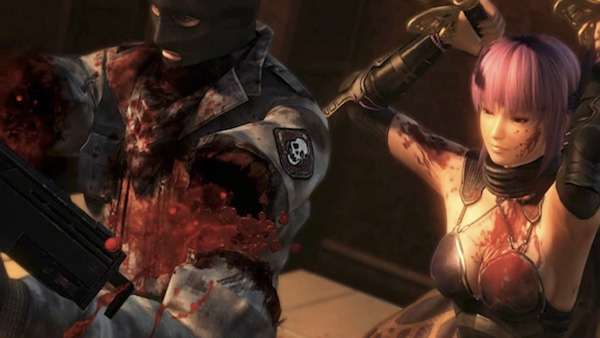
The other additions, including extra weapons and gore, feel like an extemporaneous band-aid that doesn’t quite cover the game’s problems. Enemies may be braver on the battlefield, but that doesn’t stop Ryu from splattering their entrails all over each area. Not a single enemy dies pleasantly, even when stealth-killed from behind. The same could be said of Ayane’s pointless inclusion, which also features an oil massage and towel disrobing. That said, at least her missions are the most reasonably balanced, likely because they were created separately from the original game. Ayane’s half-sister and DOA veteran Kasumi is also playable for the first time in the NG series, though nothing feels more disconnecting than the normally pacifistic kunoichi tear enemies apart with the same uncaring bloodlust as her anti-hero sibling.
Another example of clumsy pandering is the addition of extra weapons. While Ryu’s trademark staff, claws, and scythe all function as well as they did in the previous games, their inclusion in the game is done so without any meaningful context, and are simply provided to players out of thin air or when hitting save points. None of the weapons provide any tactical advantage whatsoever, and more often than not the default katana will provide more damage, especially on bosses. Classic enemies such as the Fiends are also copied and pasted into the game with no logical explanation of coherence, as are the placement of Golden Scarabs which require players to be near-sighted in order to miss any of them. Ultimately, rather than feeling like retooled additions, these features become unnecessary and fan-service, two elements that still don’t fix the main problems of the game.
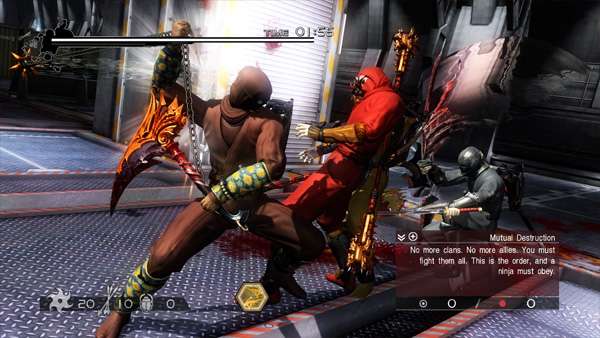
Areas are wholly uninteresting with looping hallways, the occasional wall or platform to scale over, and (most infuriating of all) an overuse of wall-scaling, which requires constant alternating presses of the shoulder buttons while also including occasional hazards or enemies that must be evaded. This wall-climbing mechanic also plagues players during certain boss fights and is never once engaging. In fact, the game will have already shown you all of its tricks within the first hour; fight enemy waves, scale some walls, fight more enemies while frantically aiming the bow at foes shooting from a distance (at least they go down in one hit and with an auto-aim assist), swan dive from impossibly large heights only to break your fall with a nearby foe, die a million times, rinse and repeat.
Ninja Gaiden 3: Razor’s Edge never had much of a chance of matching the quality of its predecessors, but it would have at least sufficed as a decent game. The unforgiving difficulty and poorly-planned gameplay restrictions only bring to light the still-present flaws of the original game rather than cover them up. Between this and the underperformed Vita port, the Ninja Gaiden series has become a mockery of its former self and now stands as the type of substandard game experiences its former creator Itagaki used to openly mock. Any goodwill left between Team Ninja’s 8-bit revival and its longtime fans is now crippled, and the deadly blow inflicted on this once-mighty action series might prove fatal.
